|
BAJAJ ALLIANZ
Bringing Tech to Life
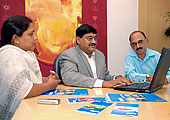 |
| All info you need is here: Bajaj
Allianz runs on IT, says Bhaskar (centre) |
It's got 900-plus offices across
India, more than one lakh agents, and 2 million customers, and
it's the fastest and the biggest private life insurance company
in India in terms of market share. So how did Bajaj Allianz, a
joint venture with the Bajajs of Bajaj Auto and Allianz ag of
Germany, go on to become numero uno in a short span of six years?
"All along, technology has been an integral part of our business
strategy," says J. Bhaskar, Head (IT), Bajaj Allianz. He
isn't exaggerating. Every aspect of the private life insurer's
strategy has an IT component built around it. Its systems are
geared to support both the primary customers (read: policy holders)
and secondary customers (agents). Result: It has a very popular
customer portal, where policyholders can not just view details
of their policy, but pay renewal premium through credit card.
"We also use the web to provide training for sales staff,"
says Bhaskar.
The company, which has an annual it budget of 1-2 per cent of
annual premium (not including sunk investment of Rs 70 crore so
far in it), has in-house core systems such as the JAD (joint application
development) and Time Boxes that help deliver new products quickly
into the market place. The system can issue 35,000 policies a
day and manage collections of 50,000 a day. The IT department,
which Bhaskar says is the backbone, also digs out numerous reports
and analyses on a daily basis. These go into supporting the decision-makers
and marketers at the company. Not rocket science, but Bajaj Allianz
evidently uses it much better than its competitors.
-Anand Adhikari
CORPORATION BANK
From ATMs to Mobile
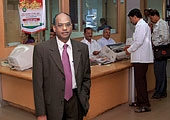 |
| Cashing in on technology: Sambamurthy's
customers may soon be able to transact via their mobiles |
ATMs and plain vanilla computer
networks don't excite B. Sambamurthy anymore. As the Chairman
and Managing Director of Mangalore-based Corporation Bank, Sambamurthy
has seen his relatively small bank (total balance sheet size of
Rs 45,000 crore compared to Rs 4,93,870 crore of behemoth, the
State Bank of India) lean on it to stay competitive. A decade
ago, Corporation Bank was one of the first to install a cash management
system, which ensured better utilisation of funds for corporate
customers and lower working capital requirement. "Technology
is a great leveller. Now the size of your branch network is no
longer the only decider, since you can reach a wider audience
by leveraging the internet and mobile phones," says Sambamurthy.
While the bank has done much more with ATMs than just dispense
cash (its customers can pay utility bills, recharge their mobile
phones and even pay insurance premia via its ATMs), it is mobile
phones that Sambamurthy sees as the next game changer. "Although
we already offer some rudimentary services such as checking your
account balance, we intend to offer a much wider range of services
on this medium soon," says the Chairman. Other services the
bank could soon offer include transfer of money between accounts,
more detailed bank statements as well as indenting for personalised
stationery like cheque books.
In a leap of faith, the bank has chosen a relatively unknown
Panacea core banking solution from the Chennai-based Laser Soft
Infosystems because it lowers the cost of transaction for its
customers. But given the bank's track record with it, it perhaps
may have found another source of competitive advantage in Panacea.
-Rahul Sachitanand
CHENNAI METROWATER
Clicking with Consumers
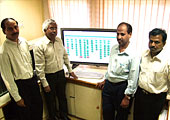 |
| Streamlined: Sahasranamam
(bespectacled) with colleagues |
Until the tsunami two years and
three months ago, excess water was never Chennai's problem; dry
taps were. So, if people in Chennai are beginning to find something
to cheer about Metrowater, it's not all courtesy the tsunami.
Recently, the 137-year-old organisation, which supplies 640 million
litres a day to 6 million people in the city, strengthened its
decade-old citizens charter to better address consumer complaints.
A key aspect of this progressive move is greater transparency-both
within and outside the board. "We were not unfamiliar with
computers, we've had them since 1986, but it was only a couple
of years ago that we inter-connected all our PCs," says A.
Sahasranamam, Chief Controller (Finance), who also looks after
the board's ERP initiative.
In 2003, a pilot project was launched using Oracle ERP 11 I
(pronounced eleven eye) in one area office. Once it proved itself
by October 2004, the board decided to extend it to all offices
(10 city offices, excluding the head office) and depots (160 of
them), besides the central storehouse. Once the storehouse was
linked, availability of information made managing the board's
business much simpler. Earlier, financial data from each of the
offices would be delivered to the head office on floppies, but
now they are online. Customers, too, can pay their bills or register
complaints at any of the depots that the head office monitors.
Metrowater has spent Rs 9 crore on the project so far, but another
100 depots still need to be linked. Sahasranamam says it will
be done shortly. After all, there's a citizens charter to live
up to.
-Nitya Varadarajan
DESICREW.IN
Savvy Start-Up
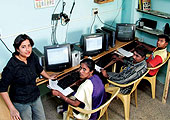 |
| Going rural: Malhotra's
(L) BPO hopes to induct 200 people this year |
It's a BPO, but barely a month old
and does more low-end work than most others. So why is DesiCrew.in
even on our list? Because, like we've mentioned elsewhere, 'most
wired' to us doesn't mean having the biggest budget for it. Rather,
it means savvy use of information technology to either differentiate
oneself or make a significant impact. And on those two counts,
25-year-old Saloni Malhotra's rural BPO is a shoo-in. Malhotra's
mission, inspired by one of iit Madras Professor Ashok Jhunjhunwala's
speeches, is to turn rural internet centres into BPOs, so that
livelihoods can be improved. "Our BPO is more like a network
that is widespread, with three seats in a centre doing several
shifts," explains Malhotra, an alumna of Pune's Bharati Vidyapeeth
engineering college.
Most of the rural BPO's projects involve data entry, digitisation
of records for government bodies, proof reading of books, and
some cad work. Revenue from projects range from Rs 30,000 to Rs
3 lakh, allowing a centre to earn Rs 8,000-12,000 a month. DesiCrew
has done work for 20 clients so far, including banks, public sector
enterprises and a publishing house.
Currently, there are 60 people in DesiCrew's network of BPOs,
and the kiosks are available through N-Logue, a firm incubated
by Jhunjhunwala's TeNet company. In other words, N-Logue sets
up rural kiosks and DesiCrew augments their income by sending
outsourced work their way. "We are just starting and there
are enormous challenges ahead," says Malhotra. "I hope
to induct at least 200 people this year." A small step for
her BPO, but a giant leap for the 200 villagers.
-Nitya Varadarajan
EVERONN SYSTEMS
Virtual Education
 |
| Class apart: A virtual classroom
in progress at Meenakshi College |
Millions of school children in India
get sub-standard education for any number of reasons: a lack of
classrooms, books, or teachers. Chennai-based Everonn Systems
believes that's a business opportunity. Set up in 1987 to promote
it education in schools (it also meant setting up the infrastructure
and training teachers), Everonn soon ventured into distance management
education. "When we saw that the concept was well understood,
we decided to take distance education to schools and colleges
in far-flung towns," says V. Kannan, Everonn's Director.
The multi-media content for its classes are developed in association
with educators, and the 'classes' themselves are held in its studios.
That means quality education is now available to hundreds of high
school children in poorly staffed and equipped schools. Currently
there are 131 private schools in its network, all in Tamil Nadu,
and 200 colleges across the four southern states. From July, classes
for grades 6, 7, and 8 will also be offered. Says Kannan: "We
are doing some pilots in Goa and Madhya Pradesh and expect some
more schools in these regions to join in."
Students who opt for Everonn's virtual classes have to pay Rs
65 a month per subject, involving 30 hours of teaching per subject.
Typically, several schools hook up simultaneously for one class.
Everonn expects to close 2006-07 with Rs 43 crore in revenues,
and has plans of investing Rs 25 crore in expansion. Kannan's
big dream is to reach 5 million students by 2010.
-Nitya Varadarajan
GMR
Bricks to Clicks
 |
| Rewiring: GMR is going in
for IT overhaul with Hegde as CTO |
One of the first things we now build
at a new project site," says Subbarao Hegde, Chief Technology
Officer of the Bangalore-based GMR Group, "is a broadband
tower so that senior managers sitting in Bangalore have access
to the latest status reports." Don't be surprised. With 36
infrastructure projects (worth hundreds of crores) in the works,
GMR has plenty of reasons to tighten the screws on project management.
The it overhaul at the group is so extensive that Hegde says GMR's
executives, business partners and other stakeholders will soon
have high-speed access to ongoing business projects, wherever
they may be built. No wonder, Hegde calls it the WAWA initiative:
work anywhere, work anytime.
To realise it's full potential, GMR is investing in a multi-layered
approach to technology, covering basic applications such as ERP,
but also looking at other business drivers such as a messaging
and collaboration platform, knowledge management portal and business
intelligence tools. With many of its executives on the road most
of the time, Hegde is also ensuring that all these applications
can be accessed on mobile devices such as PDAs, making sure critical
business data is accessible "across people, processes and
partners." For old economy companies such as GMR, coming
to grips with technology is itself half the challenge, given most
executives' disinclination to look much beyond telephones and
basic e-mails. "Everyone from the Chairman down is backing
our technology upgrade; Now, it's just a question of getting the
project done quickly so that they can begin leveraging its benefits,"
says Hegde. Indeed, GMR's team working on the multi-crore Delhi
airport modernisation plan will need it.
-Rahul Sachitanand
HERO HONDA
Plug And Play
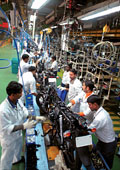 |
| Ready to roll: Hero Honda adopted ERP
pretty early |
This year, Delhi-based hero Honda
will roll out 3 million two-wheelers. That's more than 342 bikes
an hour, or 6 per minute. Each of these bikes also has around
2,000 components that go into its making. Multiply the two and
you begin to get a sense of the complexity that the world's largest
manufacturer of two-wheelers must deal with just on the manufacturing
side. Yet, if Hero Honda continues to roll out its frugal motorcycles
without missing a beat, it's because of its early start with ERP
in 1999. Apart from improving employee and shopfloor productivity,
the system has connected 250 suppliers and more than 550 dealers
across the country. "Information is updated twice a day from
the ERP system and includes details like dispatch details, warranty
claims and delivery schedules. These might seem trivial but things
like this really help," says Ravi Sud, the company CFO. Looking
at Hero Honda's numbers, you don't want to argue with him.
-Kushan Mitra
HINDUSTAN PETROLEUM
Elephant Learns to Dance
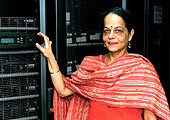 |
| Way to go: Vasudeva has helped wire
up 450 HPCL locations |
See the lady smiling in the picture
above? Look at her closely one more time. Nishi Vasudeva has the
distinction of overseeing the largest implementation of JD Edwards
EnterpriseOne in Asia. Executive Director of it & ERP at public
sector oil giant, Hindustan Petroleum Corporation (HPCL), Vasudeva
took just two years to wire up more than 450 of HPCL's locations
and 4,000 employees across India under Project Parivartan. Now,
a complex web of wide area network (wan), using leased lines,
VPN links, isdn and PSTN links among others, connects the organisation.
"Standardising on a single ERP system helped us improve efficiency
and productivity," she says as a matter of fact. "The
itinfrastructure provides the foundation for all the other services
like corporate mail, intranet, employee portal, document management
system and a slew of web-based and work flow-based applications."
Thanks to its IT investment, HPCL has been able to improve its
performance in three key areas: decision-making, customer responsiveness
and, finally, integration and standardisation of processes. If
that sounds too mundane, don't forget that HPCL is a Fortune 500
company that owns and operates two oil refineries, two cross-country
pipelines and a network that includes terminals, depots and bottling
plants. With a 17 per cent market share in the oil and gas sector,
HPCL also exports its products to countries like Bangladesh, Sri
Lanka, Nepal and Malaysia. "We have better control over our
operations and a greater understanding of business drivers,"
says Vasudeva. Like we said earlier, IT isn't about technology,
it's about business.
-Krishna Gopalan
IDEA
Look Ma, No Wires
 |
| The IBM edge: Paranjape
hopes to offer better services to customers |
Bharti Airtel proved that you don't
need to own all the servers and routers to be a most wired company.
Idea Cellular couldn't agree more. Last month, the Pune-based
mobile phone service provider signed a 10-year it outsourcing
deal with IBM that is estimated to be worth $650 million. "We
expect that the partnership with IBM will not only help us support
our aggressive growth plans from an it perspective but will also
bring in substantial value to customers, employees and shareholders,"
says Prakash Paranjape, Chief Information Officer, Idea Cellular,
which has close to 15 million subscribers.
With IBM taking care of Idea's it services, Paranjape says,
the service provider will be able to offer its customers best-in-class
solutions and innovations. "Bill Flash" is one such
service that Idea already offers its customers. This service allows
a subscriber to instantaneously get information on his billed
and unbilled amount by just punching in a four-digit code. "Besides
making our subscribers happy, this has significantly reduced pressure
on our IVR system and call centre," points out Paranjape.
Given that there aren't too many countries in the world where
scalability of telecom operators is being tested like it is in
India, outsourcing it to a vendor like IBM may be the best it
investment Idea could have made.
-Krishna Gopalan
KANSAI NEROLAC
A High-Wire Act
 |
| Modern approach: it helped
KNP re-engineer itself, says Gonsalves |
How could an 84-year-old organisation
that had an ageing workforce, conservative thinking and a structure
conducive to the past…create value for all stakeholders and
at the same time ensure that it was not a one-time effort?"
asks Jason Gonsalves, Vice President (Corporate Planning and it),
Kansai Nerolac Paints (KNP). The answer, as the embattled company
discovered, was re-engineering.
To start off, KNP migrated from its functional-based legacy
systems to a process-based systems culture by implementing the
sap R/3 solution. "ERP along with investments in connectivity,
servers and allied infrastructure, converted the organisation
from a decentralised, off-line mode, to a real-time connected
enterprise," says Gonsalves. Recognising the potential of
information as a valuable asset, KNP put in place two key business
intelligence solutions, namely data warehousing and knowledge
management.
With an it budget of 0.5-0.7 per cent of revenue (last year,
revenue was Rs 1,300 crore), the company has connected its sales
offices and factories around the country with its data centre
using a communication infrastructure based on VSATs, leased lines,
isdn, VPN. Today, the company has a smart card-based loyalty programme
for its contractors in addition to computerised colour dispensing
(CCD) machines for its dealers. Over the past year or so, KNP
has also taken to audio and video conferencing of employees in
a bid to cut cost. A vendor portal has also been launched with
an eye on better vendor management. Red, as this paints company
discovered, looks good only when it's not on your bottom line.
-T.V. Mahalingam
MARICO
Cracking a Nutty Problem
 |
| Oil's well: Copra portal
has simplified the buying process, says Kamath |
Marico buys one out of every 25
coconuts grown in India. Considering that India is among the largest
producer of coconuts in the world (producing more than 13 billion
coconuts every year), that sounds like a nutty proposition to
manage. But for Marico, the solution was simple. "We just
turned the copra buying process on its head," says Vinod
Kamath, Chief (Finance & it). Basically, Marico started a
copra portal, where instead of Marico quoting the price, the suppliers
quoted the price. Marico, then would take the final call on price
and quality. "This initiative was particularly challenging
due to the fact that the vendors/ traders were not it savvy,"
recalls Kamath. Today, the company, which has an IT budget of
Rs 5 crore per annum, has implemented SAP-SRM to integrate the
packing material suppliers.
With the company's dependence on agricultural produce like copra,
sunflower and sunflower seeds, crop estimation and market forecasting
are a crucial part of major buying decisions. Marico uses field
survey personnel for data collection and estimation. "The
data collected by these personnel is transmitted on a daily basis
using the FSP Portal, which otherwise would take at least a fortnight
for collation and aggregation. This initiative will ensure the
availability of data to make better buying decisions," says
Kamath.
That apart, Marico integrated its customers on one side and
vendors and distributors on the other. It has also piloted the
use of PDAs for sales force automation and plans to roll it out
in full scale shortly. And you thought marketing oils was a simple
business.
-T.V. Mahalingam
KALYAN DOMBIVLI MUNICIPAL CORPORATION
Model Municipality
 |
| Showing the way: Corporation's
Systems Manager Subhash Patil |
It is one of the most successful
e-governance stories in India, and it is set in-no, not Hyderabad-but
Kalyan Dombivli, a suburb in Thane district. About five years
ago, the Kalyan Dombivli Municipal Corporation (KDMC) decided
to create citizen facilitation centres (CFCs) and urban local
bodies to bring about greater accountability and transparency
in its operations. The results, to say the least, have been stunning.
Assessment of property now takes just 21 days, with 24 KDMC staffers
working on it compared to 62 previously; disputes over bills have
dropped from 25 to 2 per cent of new assessments; a new water
connection now takes two weeks rather than six; and KDMC's revenue
in 2006-07 is expected to be Rs 245 crore, and Rs 340 crore next
year. "The e-governance project has helped citizens get their
work done at a much faster pace, and the corporation earns almost
90 per cent more in tax revenues," says R. D. Shinde, Municipal
Commissioner, KDMC.
There are six CFCs apart from the one at KDMC headquarters across
Kalyan and Dombivli's seven wards, and citizens can walk in at
any of these CFCs and avail of the corporation's services. These
six CFCs are connected online with the central servers and offer
more than 90 corporation services across the counters. Not surprisingly,
KDMC has become a municipal model not just within Maharashtra,
but the central government has expressed interest in replicating
its model across India.
-Anusha Subramanian
NARAYANA HRUDAYALAYA
Wiring the Unwired
 |
| Reaching out: Shetty's hospital
treats thousands of patients remotely |
Annually, just 70,000 cardiac procedures
are conducted in India, even though more than 2.5 million are
required. The problem is that just a fraction of the population
has access to specialised healthcare because the best doctors
sit in distant hospitals in large cities. Rather than bring patients
to specialty centres such as Narayana Hrudayalaya, a six-year
old cardiac centre on Bangalore's Hosur Road, the hospital now
treats thousands of patients remotely, using technology ranging
from the humble telephone line to a dedicated broadband set up
to transmit images like electrocardiograms (ECGs) from remote
towns and villages to specialists at Narayana Hrudayalaya. Elsewhere,
the 53-year-old Shetty plans to lean on the network of 1.65 lakh
post offices nationwide (and the rudimentary connectivity many
of them have) to expand his Hrudayalaya Post initiative. "Almost
99 per cent of the cases we see don't have to make the long journey
to Bangalore or other large towns for simple tests such as ECG,"
says Dr Shetty.
The doctor says that his hospital can replicate its success
in cardiology in several other areas of medicine that require
remote assistance such as eye care, where images can be viewed
virtually. Technology and connectivity will also help Narayana
Hrudayalaya execute the ambitious Pan-African Network, mooted
by President A.P.J. Abdul Kalam. "We will be connected to
all 53 nations in Africa to try and address some of their most
critical healthcare needs," says Dr Shetty. Impressive? You
bet.
-Rahul Sachitanand
NORTH DELHI POWER
Out of Darkness
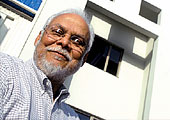 |
| Powering change: Panday
wants NDPL to be a trendsetter |
In July 2002, when Tata Power got
the control of North Delhi Power Ltd (NDPL), one of the three
privately managed power distributors that came into being after
unbundling of Delhi Vidyut Board (DVB), its officials found two
out-of-date computers in its main office. Since the PCs were still
partially packed, it remains an abiding mystery whether or not
they were ever used by the DVB officials. The story today couldn't
be more different. NDPL, which supplies electricity to a population
of 5 million in north and north-west Delhi, has been able to bring
its aggregate technical and commercial (AT&C) losses down
to 26.52 per cent in March 2007 from 47.79 per cent in 2002. What
helped? A Supervisory Control and Data Acquisition System (SCADA)
that NDPL has implemented for 11 grids so far; it allows better
control over distribution. That apart, its ERP system generates
a 'dashboard' of key performance indicators that the top managers
can employ to take decisions
More visible, however, are the improvements in customer service.
"NDPL is the first power distribution company in India to
have posted the consumption, billing and payment record of all
its customers on its website. We have also implemented automatic
meter reading technology that collects data from meters and transfers
it to a central database," says Akhil Panday, Principal Executive
Officer, NDPL. The 'billing efficiency' (the percentage of consumers
billed on their actual consumption rather than on compromised
estimates) increased from 54 per cent in 2002 to 98 per cent in
March 2007.
NDPL's website also provides for registration of complaints
and status check on those complaints. "We want to become
a model in power distribution," says Panday. Good for India.
-Kapil Bajaj
RELIANCE RETAIL
Retailer in a Rush
 |
| Taking stock: Reliance uses
technology to track buying trends |
In less than five months, Reliance
Retail has opened 96 retail stores, spread across 9 cities and
already has on its roster half a million customers signing up
for its loyalty programme. Reliance Retail is on a roll. But the
roll-out couldn't have been possible without state-of-the-art
technology, which peeks out at every end of Reliance's retail
strategy. At the front-end, the company uses Wincor touchscreen
billing terminals with Metrologic bi-optic scanners that scan
and weigh merchandise simultaneously, cutting down waiting time
at the checkout counter.
Reliance has chosen Israel's Retalix Storeline pos and Retalix
Loyalty software for managing point-of-sale transactions and loyalty
programmes. The front-end transmits data to the enterprise resource
planning (ERP) system at the back-end in real time. All its stores
and distribution centres are connected by VPN/broadband. The data
collected from the checkout counters helps the company track customer
buying trends, average ticket size and choice of items. Based
on this, the company can manage and plan for its stock-keeping
units (SKUs) and determine stocking levels across its range of
products.
In its farm-to-fork strategy, Reliance Retail is eliminating
the middle-man and sourcing produce directly from the producers.
At the same time it wants to ensure that physical handling of
stocks is minimised. It currently relies on bar-coding of crates
and racks at the distribution centres from where the product is
picked up, but pilot runs with Radio Frequency Identification
(RFID) tags are on. As the network expands and scales up, tracking
the movement of products will become more critical. Wal-Mart is
supposed to run the world's largest private it network. Perhaps
Reliance Retail will end up running India's biggest.
-E. Kumar Sharma
SHAMRAO VITTAL CO-OP BANK
Banking Big On IT
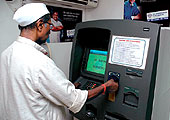 |
| Easy access: Shamrao Bank
has its own in-house banking software |
Back in the early 2000s, the Mumbai-based
Shamrao Vittal Co-operative Bank made a mark by being one of the
pioneers among its peers to adopt a bevy of it initiatives. As
early as 2003, the bank installed Voice Over Internet Protocol
(VOIP telephony to connect its three dozen branches and four extension
counters, slashing its intra-branch communication costs. When
customers were initially reluctant to accept the newly-introduced
ATM technology on security grounds, the bank introduced e-tokens
(temporary ATM cards) for withdrawal of money from an ATM. "It
greatly reduced the initial fear factor on the part of the customers,"
remembers Ravikiran Manikikar, it Head at the bank.
What may seem as small steps was a giant leap for this 100-year-old
bank at a time when co-operative banks were falling down like
nine pins because of huge pressure on their margins. The bank
used technology to shave costs and keep its bottom line healthy.
It developed an in-house banking software, 'Genius-1', which was
implemented in all its branches in 2004. By connecting all the
branches electronically, the bank was able to offer services that
were akin to 24X7 banking. Besides, the bank introduced SMS and
tele-banking for its growing breed of tech savvy customers and
was the first co-op to introduce a two-hour remittance system.
Next on the anvil, says Manikikar, is an electronic gateway that
will help its customers pay utility bills, and tie-ups with other
banks to provide its nearly a million customers access to more
than 8,000 ATMs.
-Anand Adhikari
SUMUL
C for Cow, M for Mouse
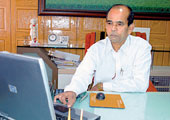 |
| White revolution: Sumul
Chairman Manubhai Patel |
In more than 1,000 village societies
in Gujarat's Surat district, some 250,000 farmers selling their
milk through the Surat Milk Producers' Union (Sumul) are an it
empowered lot. Using an online integrated computer system (OICs),
farmers in 450 of the 1,008 village milk co-operative societies
in the district can now know exactly what transactions they have
done and how much they will earn. Sumul is one of the 12 district
unions that produce dairy products for the Gujarat Cooperative
Milk Marketing Federation (GCMMF), which markets Amul and Dhara
brands, and has used technology to boost efficiency at the milk
co-operative. Says Jayesh Desai, Sumul's MD: "Automating
the village societies has helped us increase efficiency considerably.
We get the necessary information on time, which has helped in
accurate decision-making."
Of its annual turnover of Rs 600 crore, Sumul earmarks Rs 5
crore for its IT budget and is now connecting all the 1,000-odd
villages with wireless and leased telecom lines. Recently, it
introduced communication kiosks (with email, video conferencing
and VOIP telephony) for farmers in some of the villages with a
target of covering all of them by end-2007.
-Anusha Subramanian
TATA MOTORS
Bottom Line Booster
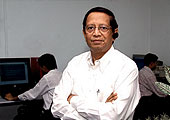 |
| Smooth driving: Tata Motors
has the largest automotive CRM base |
You would imagine that at an engineering-intensive
company such as Tata Motors, it would play a crucial role. And
you would be right-but only partly. Because at the Pune-based
automotive major, it isn't just a tool, it's a bottom line booster.
"it is an integral part of the company's process stream.
The bottom line growth is inconceivable without it support,"
says the company's Senior General Manager (IT), Probir Mitra.
At Tata Motors, it is classified into Engineering Systems (CAD/CAM)
and Business Systems, which includes manufacturing and procurement.
According to Mitra, the company has developed a knowledge-based
engineering framework called knext, which reduces design cycle
time and integrates design tools and processes. "It also
helps in training the new recruits on processes and brings them
to a productive level in a very short time," adds Mitra.
On the business side, it is said to manage the largest CRM user
base of all auto companies in the world, covering 500 dealer branches
and 13,000 users. "This has replaced hundreds of fragmented
dealer systems with one integrated application for our dealers
and us," says Mitra. In the case of retail financing, the
company has implemented sap-Lease Accounting and Management (SAP-LAM),
the first in Asia and third worldwide. This system has been integrated
with the CRM system. However, Tata Motors' CRM system is about
to get tested like never before: the mass-market Rs 1-lakh car
isn't too far away.
-Krishna Gopalan
TTDT
Pilgrims' Progress
 |
| Gateway to Tirupathi: Biometrics
has helped simplify things for devotees |
On an average day, 45,000 devotees
throng the Venkateshwara Temple on the Tirumala Hills in Andhra
Pradesh. On special days, that number can burgeon to 120,000.
For the Tirumala Tirupathi Devasthanam Trust (TTDT), which manages
the famous temple, handling such numbers would have been a nightmare
had it not been for technology, admits A.P.V.N. Sarma, an IAS
officer in charge of TTDT.
Time was when devotees flocking from India and around the world
to the temple had to wait in cage-like enclosures for time periods
varying from 6-48 hours for their turn to pay obeisance to the
deity. Then, in 1999, the temple opted for a bar coding technology
where a wristband with a bar code detailing the time of the 'darshan'
was provided to each pilgrim. But that led to a scalpers' market
in wristbands, with people trading them at a premium. Moreover,
in the searing summer heat, the barcodes would fade or the wristbands
tear.
To overcome all these challenges, in 2003, TTDT adopted biometrics.
An impression of the index finger and a back-up photo of the face
is taken for each pilgrim using a webcam at Tirupati, the base
station before entering the Tirumala Hills. The data is then seamlessly
transferred to the temple precincts where fingerprint and photos
are matched before each pilgrim is allowed to proceed for 'darshan'.
This has slashed the waiting time for devotees down to a few hours.
God bless it.
-Venkatesha Babu
VIIT
Wired Campus, Wired Town
 |
| Reducing the digital divide:
And VIIT is doing its bit, says Goje |
Baramati, 120 km away from Pune,
is a town most people, with the exception of keen trackers of
politics, would not have heard of. But it has been in the news
in recent times for non-political reasons. Last November, Intel
Chairman Craig Barrett chose this nondescript town as a location
for implementing Wimax for the first time in India. And helping
the chip giant in the project is a local college called Vidya
Pratishthan's Institute of Information Technology (VIIT).
Established in 2000, the 30-acre campus has a network of more
than 250 computers powered with Gigabit Fiber Optic Cable. Besides,
most of its buildings have a Wi-Fi connection. In addition, online
tests are the order of the day at the campus. A brainchild of
Indian cricket's big boss and Union Agriculture Minister Sharad
Pawar, VIIT has been at the forefront of implementing several
Information, Communication and Technology (ICT) projects in the
region. "We made it a part of our mandate to disseminate
it among the people who did not have access," says Amol Goje,
Director, VIIT. "We wanted to do our bit to reduce the digital
divide," adds Goje.
Today, the people of Baramati can boast of world class connectivity
thanks to the deployment of Wireless Local Loop (WLL). VIIT also
runs a community radio service for nearly 7 hours every day, reaching
out to 30,000 farmers. It has also been instrumental in setting
up a telemedicine project initiated by Intel, cardiac and ophthalmologic
consultations to local residents.
-T.V. Mahalingam
|
























